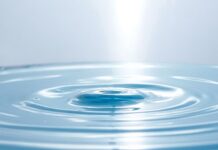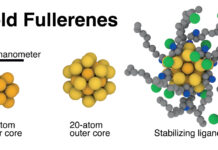
The colored lines represent the lowest three bands. h, The first bulk Brillouin zone of the Weyl phononic crystal and associated projected surface Brillouin zones. The colored spheres in g and h label Weyl points with different topological charges. i–k, Simulated SAW dispersions (green lines) at kz = 0.5π/h for the three side surfaces XZ1, YZ1 and XZ2, respectively, agree very well with our measurements (bright colors in the color scale, which represents the Fourier transformation of the measured pressure field). l–n, The corresponding EFCs in the extended surface Brillouin zones, simulated and measured at the Weyl frequency of 5.75 kHz. The grey regions display the projected bulk bands, the blue spheres label the projected Weyl points K and K′, and the green arrows indicate the directions of the SAW group velocities. Credit: Nature (2018). DOI: 10.1038/s41586-018-0367-9 Read more at: https://phys.org/news/2018-08-artificial-material-negative-refraction.html#jCp
A team of researchers with members from Wuhan University and the University of Texas has created an artificial material that offers both negative refraction and no reflection. In their paper published in the journal Nature, the group describes their material, how it was made, and possible uses for it. Baile Zhang with Nanyang Technological University offers a News & Views piece on the work done by the team in the same journal issue.
As most kids learn in school, when light rays strike a body of water, some are bent by the water, while others are reflected. Baile notes that in such situations, the incident and refracted rays wind up on opposite sides of the surface of the water—which opticians describe as the norm. He also notes that this is what happens with virtually all materials in nature. But he also notes that theory suggests that it should be possible to create materials that violate the norm. In this new effort, the researchers have created just such a material.
The researchers report that they made the new material by first studying the properties of a Weyl semimetal—a recently discovered quantum material that has interesting topological properties. To apply what they learned to a non-metal material, they created trilayer plates of phononic crystals using epoxy and other materials (shaped in a specific way). They then stacked the plates in twisted counterclockwise fashion by 2π/3 along the vertical axis. In so doing, they found that the resultant material not only exhibited negative refraction but also absorbed all of the acoustic waves aimed at it, reflecting none.
Baile suggests that the material could lay the groundwork for new developments in many areas—if a similar material can be created to behave the same way with optical waves, for example, that could lead to new types of optical systems. He notes that such a material could likely find many uses in acoustical systems as well, such as improved ultrasonic devices. He further notes that reflection-free materials could improve the efficiency of many current devices.
Read more: Artificial material that has negative refraction and no reflection
thumbnail courtesy of phys.org















